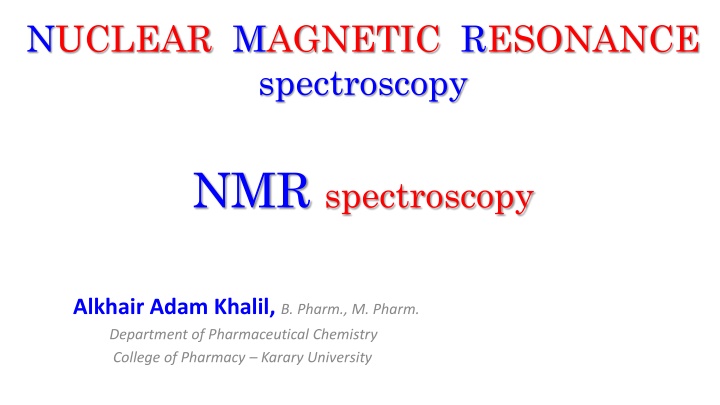Introduction to NMR Spectroscopy: A Powerful Tool for Structural Analysis
Nuclear Magnetic Resonance (NMR) spectroscopy is a vital technique in determining the structure of organic molecules. It complements IR and UV spectroscopies by providing a detailed map of the carbon-hydrogen framework. Understanding the physics behind NMR, such as nuclear spin and the effect of magnetic fields, is crucial for its application. Proton NMR and carbon NMR are common types used for characterizing organic structures. By matching energy differences between states, NMR uncovers valuable information about molecular composition.
Download Presentation

Please find below an Image/Link to download the presentation.
The content on the website is provided AS IS for your information and personal use only. It may not be sold, licensed, or shared on other websites without obtaining consent from the author.If you encounter any issues during the download, it is possible that the publisher has removed the file from their server.
You are allowed to download the files provided on this website for personal or commercial use, subject to the condition that they are used lawfully. All files are the property of their respective owners.
The content on the website is provided AS IS for your information and personal use only. It may not be sold, licensed, or shared on other websites without obtaining consent from the author.
E N D
Presentation Transcript
NUCLEAR MAGNETIC RESONANCE spectroscopy NMR spectroscopy Alkhair Adam Khalil, B. Pharm., M. Pharm. Department of Pharmaceutical Chemistry College of Pharmacy Karary University
Weve seen up to this point that IR spectroscopy provides information about a molecule s functional groups and that UV spectroscopy provides information about a molecule s conjugated electron system. Nuclear magnetic resonance(NMR) complements these techniques by providing a map of the carbon hydrogen framework in an organic molecule. Taken together, IR, UV, and NMR spectroscopies often make it possible to find the structures of even very complex molecules. spectroscopy
In this lecture we are going to know about a new spectroscopic technique: NMR Spectroscopy The physics behind NMR: Nuclear spin Charges and magnetic field Effect of Radio waves on nuclear spin Effect of electron s local magnetic field shielded and deshielded nuclei
Two common types of NMR spectroscopy are used to characterize organic structure: 1H NMR (proton NMR) is used to determine the number and type of hydrogen atoms in a molecule; and 13C NMR (carbon NMR) is used to determine the type of carbon atoms in a molecule.
Before you can learn how to use NMR spectroscopy to determine the structure of a compound, you need to understand a bit about the physics behind it. Keep in mind, though, that NMR stems from the same basic principle as all other forms of spectroscopy. Energy interacts with a molecule, and absorptions occur only when the incident energy matches the energy difference between two states.
Magnetic Resonance Nuclear In the Nucleus Involves Magnets In the Nucleus
Nuclear spin Elements (isotopes) with either odd mass or odd atomic number have the property of nuclear spin
Only nuclei that contain odd mass numbers (such as numbers (such as signals. Because both allows us to map the carbon and hydrogen framework of an organic molecule. 1H, 13C, 19F, and 2H and 31P) or odd atomic 14N) give rise to NMR 1H and 13C, are NMR active, NMR
Nuclear spin The spin quantum number (I) is related to the atomic number and mass number of the nucleus. NMR active Not NMR active Because of its charge and spin; a nucleus can behave like a tiny magnet.
When a charged particle such as a proton spins on its axis, it creates a magnetic field. For the purpose of this discussion, therefore, a nucleus is a tiny bar magnet, symbolized by Normally these nuclear magnets are randomly oriented in space,
But in the presence of an external magnetic field, (symbolized by B0), they are oriented with or against this applied field. More nuclei are oriented with the applied field because this arrangement is lower in energy, but the energy difference between these two states is very small (< 0.4 J/mole)
In a magnetic field, there are now two different energy states for a proton: A lower energy state with the nucleus aligned in the samedirection as B0 A higher energy state with the nucleus aligned opposed to B0 When an external energy source (h ) that matches the energy difference ( E) between these two states is applied, energy is absorbed, causing the nucleus to spin flip from one orientation to another (Transition).
The source of energyin NMR is radio waves. Radiation in the radiofrequency region of the electromagnetic spectrum (so-called RF radiation) has very long wavelengths, so its corresponding frequency and energy are both low. When these low-energy radio waves interact with a molecule, they can change the nuclear spins of some elements, including 1H and 13C.
Therefore; NUCLEAR MAGNETIC RESONANCE
Thus, two variables characterize NMR: 1. An applied magnetic field measured in tesla (T). 2. The frequency of radiation used for resonance, measured in Megahertz (MHz). The frequency needed for resonance and the applied magnetic field strength are proportionally related:
Early NMR spectrometers used a magnetic field strength of ~1.4 T, which required RF radiation of 60 MHz for resonance. Modern NMR spectrometers use stronger magnets, thus requiring higher frequencies of RF radiation for resonance. For example, a magnetic field strength of 7.05 T requires a frequency of 300 MHz for a proton to be in resonance.
If all protons absorbed at the same frequency in a given magnetic field, the spectra of all compounds would consist of a single absorption, rendering NMR useless for structure determination. Fortunately, however, this is not the case.
Local field The frequency at which a particular proton absorbs is determined by its electronic environment. Because electrons are moving charged particles, they create a magnetic field (local field) opposed to the applied field B0, and the size of the local magnetic field generated by the electrons around a nucleus determines where it absorbs.
Modern NMR spectrometers use a constant magnetic field strength B0, and then a narrow range of frequencies is applied to achieve the resonance of all protons.
Effect of local field Nuclei that are not in identical structural situations do not experience the external magnetic field to the same extent. The nuclei are shielded or deshielded due to small local fields generated by circulating sigma, pi and lone pair electrons.
Effect of local field When the electrons circulate, they generate a small magnetic field that happens to point in the opposite direction to the external field Therefore, the nucleus experiences a reduced external magnetic field and resonate at lower frequency. This is typically known as shielding , e.g. Hydrogens like those in methane are said to be shielded .
Effect of local field One the other hand hydrogens near an electronegative atom should require a higher frequency to flip (e.g. CH3Br) because bromine atom pulls away electron toward itself, this is known as deshielding , and the hydrogens of the methyl group are said to be deshielded therefore they experience (sense) more of the external applied field making them to resonate at higher frequency.
Summary A nucleus is in resonance when it absorbs RF frequency and the spin flips into higher energy state. Only nuclei that contain odd mass numbers or odd atomic numbers give rise to NMR signals (such as 1H and 13C) Two variables characterize NMR: 1. An applied magnetic field measured in tesla (T). 2. The frequency of radiation used for resonance, measured in Megahertz (MHz). The frequency at which a particular proton absorbs is determined by its electronic environment (i.e. local field).
1H NMR Spectrum To be continued next lecture.























